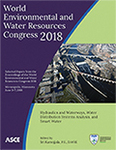World Environmental and Water Resources Congress 2018
Hydrodynamic Change Following Living Shoreline Restoration Based on a Before-After-Control-Impact Experiment
Publication: World Environmental and Water Resources Congress 2018: Hydraulics and Waterways, Water Distribution Systems Analysis, and Smart Water
ABSTRACT
Preventing shoreline erosion is critically important as coastal hazards intensify. Living shoreline stabilization protects vulnerable coastal assets while promoting biodiversity. However, increased understanding of impacts to physical processes could improve restoration designs. This before-after-control-impact study quantifies hydrodynamic change resulting from restoring a degraded estuarine shoreline using living shoreline techniques. The eroding shoreline, located in Florida’s Mosquito Lagoon, was restored using oyster shell bags and emergent vegetation. Hydrodynamic data were collected from three shoreline sites (the Restored shoreline, a Control degraded shoreline, and a control Reference shoreline stabilized by mature mangroves) before and after living shoreline implementation. We find immediate and pronounced hydrodynamic effects attributed to restoration. Incoming velocities were reduced in the Restored site soon after restoration and significant wave heights were attenuated by the living breakwaters. Notably, onshore-offshore gradients of mean velocities and turbulence statistics within the restored site differed from the reference shorelines.
Get full access to this chapter
View all available purchase options and get full access to this chapter.
REFERENCES
Bozek, C. M. and Burdick, D. M., (2005). Impacts of seawalls on saltmarsh plant communities in the Great Bay Estuary, New Hampshire U.S. Wetlands Ecology and Management, 13(5), pp. 553–568.
Coen, L. D., Luckenbach, M. W. and Breitburg, D. L., (1999), April. The role of oyster reefs as essential fish habitat: a review of current knowledge and some new perspectives. In American Fisheries Society Symposium (Vol. 22, pp. 438–454).
Costanza, R., de Groot, R., Sutton, P., van der Ploeg, S., Anderson, S. J., Kubiszewski, I., Farber, S. and Turner, R. K., (2014). Changes in the global value of ecosystem services. Global Environmental Change, 26, pp. 152–158.
Gedan, K. B., Kirwan, M. L., Wolanski, E., Barbier, E. B. and Silliman, B. R., (2011). The present and future role of coastal wetland vegetation in protecting shorelines: answering recent challenges to the paradigm. Climatic Change, 106(1), pp. 7–29.
Gittman, R. K., Peterson, C. H., Currin, C. A., Joel Fodrie, F., Piehler, M. F. and Bruno, J. F., (2016). Living shorelines can enhance the nursery role of threatened estuarine habitats. Ecological Applications, 26(1), pp. 249–263.
Gittman, R. K., Scyphers, S. B., Smith, C. S., Neylan, I. P. and Grabowski, J. H., (2016). Ecological consequences of shoreline hardening: a meta-analysis. BioScience, 66(9), pp. 763–773.
Goring, D. G. and Nikora, V. I., (2002). Despiking acoustic Doppler velocimeter data. Journal of Hydraulic Engineering, 128(1), pp. 117–126.
Griggs, G. B., (2005). The impacts of coastal armoring. Shore and Beach, 73(1), pp. 13–22.
Horstman, E. M., Dohmen-Janssen, C. M., Narra, P. M. F., Van den Berg, N. J. F., Siemerink, M. and Hulscher, S. J. M. H., (2014). Wave attenuation in mangroves: A quantitative approach to field observations. Coastal engineering, 94, pp. 47–62.
McGranahan, G., Balk, D. and Anderson, B., (2007). The rising tide: assessing the risks of climate change and human settlements in low elevation coastal zones. Environment and Urbanization, 19(1), pp. 17–37.
Nepf, H. M., (1999). Drag, turbulence, and diffusion in flow through emergent vegetation. Water Resources Research, 35(2), pp. 479–489.
Nicholls, R. J. and Cazenave, A., (2010). Sea-level rise and its impact on coastal zones. Science, 328(5985), pp. 1517–1520.
Piazza, B. P., Banks, P. D. and La Peyre, M. K., (2005). The potential for created oyster shell reefs as a sustainable shoreline protection strategy in Louisiana. Restoration Ecology, 13(3), pp. 499–506.
Plant, N. G. and Griggs, G. B., (1992). Interactions between nearshore processes and beach morphology near a seawall. Journal of Coastal Research, pp. 183–200.
Wahl, T. L., (2003). Discussion of “Despiking acoustic doppler velocimeter data” by Derek G. Goring and Vladimir I. Nikora. Journal of Hydraulic Engineering, 129(6), pp. 484–487.
Information & Authors
Information
Published In
World Environmental and Water Resources Congress 2018: Hydraulics and Waterways, Water Distribution Systems Analysis, and Smart Water
Pages: 54 - 64
Editor: Sri Kamojjala, Las Vegas Valley Water District
ISBN (Online): 978-0-7844-8142-4
Copyright
© 2018 American Society of Civil Engineers.
History
Published online: May 31, 2018
Authors
Metrics & Citations
Metrics
Citations
Download citation
If you have the appropriate software installed, you can download article citation data to the citation manager of your choice. Simply select your manager software from the list below and click Download.
